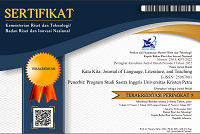Society Treatment and Self Acceptance toward Imperfections in Imperfect
DOI:
https://doi.org/10.9744/katakita.11.1.114-123Keywords:
kunci-tranparancy, accountability, responsibility, independency dan fairness.Abstract
Imperfect is one of the Indonesian comedy films that has gone viral in Indonesia. It tells the story of a woman who works in a beauty company who gets different treatment because her appearance does not meet beauty standards. This research was conducted to reveal how society's attitude treats women who do not comply with beauty standards and to find out Rara's reasons for refusing to follow the beauty standards set by society. This study uses the theory of lookism and sizeism. Where patriarchal values have internalized women to participate in discriminating against Rara or women who do not follow beauty standards. The discrimination Rara received from society was discrimination against body shape, skin color and the way she appeared in public. After following the beauty standards, Rara feels uncomfortable and conflicts often occur between her and those closest to her. Rara decides to refuse to follow the standard of beauty that has been set by society with self-acceptance and seeks her happiness.
References
Aryani, E. (2019). Pengaruh label best seller terhadap kepuasan pembelian buku. [Undergraduate thesis, Universitas Islam Negeri Syarif Hidayatullah Jakarta]. Institutional Repository UIN Syarif Hidayatullah. https://repository.uinjkt.ac.id/dspace/handle/123456789/49912
Barli, C. Sili S., Valiantien, N.M. (2017). Women portrayal in patriarchal society through female main characters in Zemeckis’s Beowulf Film (2007). Jurnal Ilmu Budaya, 1(3), 233-244. http://dx.doi.org/10.30872/jbssb.v1i3.674
Becker, M. (1999). Patriarchy and inequality: Towards a substantive feminism. University of Chicago Legal Forum, 1(3), 21-88.
Briandana, R. and Dwityas, N.A. (2018). Comedy films as social representation in the society: An analysis of Indonesian comedy films. International Journal of Humanities and Social Science Studies, 4(5), 107-118.
Chaniago, R. H. (2017). Analisis Perkembangan Film Komedi Indonesia. Nyimak: Journal of Communication, 1(2), 189-195. http://dx.doi.org/10.31000/nyimak.v1i2.482
Colman, F. (2014). Film, theory and philosophy: The key thinkers. Routledge.
Fauzia, F.T., Ratri, R.L. (2019). Memahami pengalaman body shaming pada remaja perempuan. Interaksi Online, 7(3), 238-248.
https://ejournal3.undip.ac.id/index.php/interaksi-online/article/view/24148
Gaffney, K. J. (2017). Negative effects that social media causes on body imaging. [Undergraduate Honors College Theses, Long Island University]. Digital Commons Long Island University. https://digitalcommons.liu.edu/post_honors_theses/13/
Hammer, C. (2017). A look into lookism: An evaluation of discrimination based on physical attractiveness. [Undergraduate Honors Capstone Projects, Utah State University]. Digital Commons Utah State University. https://doi.org/10.26076/e752-7602
Chrisler, Joan C., & Barney, A. (2016). Sizeism is a health hazard. Fat Studies, 6(1), 38-53.
https://doi.org/10.1080/21604851.2016.1213066
Johnson, A. G. (1997). The gender knot: Unraveling our patriarchal legacy. Temple University Press.
Kurniawan, B. (2019). Hybridity in action and crossing ethnic boundaries in the films Ngenest and Cek
Toko Sebelah. Lingua Cultura, 13 (2), 127-135. https://doi.org/10.21512/lc.v13i2.5700
Macpal, S., Azhar, F. (2020). High heels sebagai agensi bagi tubuh wanita. Anthropos: Jurnal Antropologi Sosial dan Budaya, 5(2): 196-205. https://doi.org/10.24114/antro.v5i2.15362
Rawat, PS. (2014). Patriarchal beliefs, women’s empowerment, and general well-being. Vikalpa, 39(2), 43–56. https://doi.org/10.1177/0256090920140206
Santoso, A., (2018). Polisi tangani 966 kasus body shaming selama 2018. Detik. https://news.detik.com/berita/d-4321990/polisi-tangani-966-kasus-body-shaming-selama- 2018]
Smith, E. O., & Helms, W. S. (1999). Natural selection and high heels. Foot and Ankle International, 20(1), 55-57. https://doi.org/10.1177/107110079902000113
Soleman, N., & Elindawati, R., (2019) Fourth wave feminism in Indonesia: body shaming through social media phenomenon. Journal of Islamic World and Politics, 3(2) 588-602. https://doi.org/10.18196/jiwp.3234
Sutin, A. R., Stephan, Y., & Terracciano, A. (2015) Weight discrimination and risk of mortality. Psychol Sci. 26(11): 1803–1811. https://doi.org/10.1177/0956797615601103
Walby, S. (1990). Theorizing patriarchy. Sociology, 23(2), 213-234. https://doi.org/10.1177/0038038589023002004
Warhurst, C., Broek, D. van den, Hall, R., & Nickson, D. (2015). Lookism: the new frontier of employment Discrimination?. Journal of Industrial Relations 51(1), 131-136. https://doi.org/10.1177/0022185608096808
Downloads
Published
Issue
Section
License
Authors who publish with this journal agree to the following terms:- Authors retain copyright and grant the journal right of first publication with the work simultaneously licensed under a Creative Commons Attribution License that allows others to share the work with an acknowledgement of the work's authorship and initial publication in this journal.
- Authors are able to enter into separate, additional contractual arrangements for the non-exclusive distribution of the journal's published version of the work (e.g., post it to an institutional repository or publish it in a book), with an acknowledgement of its initial publication in this journal.
- Authors are permitted and encouraged to post their work online (e.g., in institutional repositories or on their website) prior to and during the submission process, as it can lead to productive exchanges, as well as earlier and greater citation of published work (See The Effect of Open Access).














